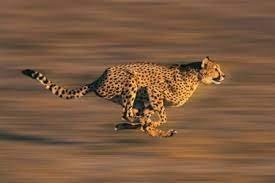28 Jul 2022 Ecostani / Despite concerns, the Cheetah project is worth pursuing

- Cheetah is the fastest land animal which was declared extinct in India in the year 1952. Now once again a plan is underway to bring him to India, under which he will be rehabilitated in the Kuno-Palpur National Park (KNP) in Madhya Pradesh. These African cheetahs are being brought under an inter-continental transfer project between India and Africa (mainly from South Africa and Namibia).
- Plans to bring cheetahs to India, initially from Iran and now from the African continent, have been going on for decades and have been controversial enough. Many conservationists in India are skeptical of the plan’s success and fear it will divert attention away from the conservation of other endangered species in need of relocation, such as the Asiatic lion.
India’s rationale behind the return of the cheetah and the associated challenges:
Biological Purpose:
- To reestablish its ecosystem function role in representative areas of the cheetah’s former habitat and contribute to the global effort towards the conservation of the cheetah as a species.
- After bringing back the cheetah, India will become the only country where all the five members of the ‘Big Cat’ species – tiger, lion, panther, snow leopard and cheetah will be present.
Increase in livelihood options:
- The reintroduction of cheetahs will enhance livelihoods for local communities in and around those areas through increased revenues from ecotourism and related activities.
Sustaining the food chain:
- Apex predators control all levels in the food chain and are considered the umbrella species for the food chain (Umbrella species).
- Cheetah may prove to be a key and umbrella species for mobilizing resources to restore open forest ecosystem and restore balance in food web.
Climate Change Mitigation:
- It will enhance India’s capacity for carbon sequestration through ecosystem restoration activities in cheetah conservation areas and thereby contribute to global climate change mitigation goals.
Reasons for the extinction of cheetahs in India:
- The cheetah in India has been recorded in history since before AD. Records of cheetahs being caught date back to the 1550s.
- A decrease in the level of genetic diversity due to a historical genetic bottleneck, resulting in its high infant mortality rate in the wild and its low ability to breed in captivity were some of the major factors in its extinction.
Hunting Entertainment:
- For centuries, cheetahs (both male and female) were widely and continuously captured from forested areas for hunting purposes.
- Detailed accounts of its contact with humans are available since the 16th century when it was recorded by the Mughals and other kingdoms of the Deccan.
‘Bounty Killing’:
- The British increased the species’ crisis by announcing a reward for killing it in the year 1871.
- The final phase of its extinction was completed with the end of British colonial rule.
- It is recorded that the last remaining cheetahs were killed in India in 1947 and were officially declared extinct in 1952.
Challenges associated with relocation of cheetah to India
Transition from enclosure to forest area:
- An important problem is whether a cheetah living in a cage and dependent on humans for food will be able to hunt on its own if released into the wild.
- For example, a tigress named Sundari (who had returned from Satkosia in Odisha after a failed rehabilitation effort) was eventually placed in Bhopal Zoo for life.
Adaptability:
- Re-introduced species are more vulnerable to the effects of drift, selection and gene flow evolutionary processes due to their smaller size and climatic and ecological differences between source and native habitats.
- African cheetahs need a long open space to run. Indian gardens are much smaller than those in Africa; thus providing less opportunity for their free movement.
- Studies in Africa have shown that female cheetahs stay alone and roam long distances, while males defend their small territories and bond with passing females. It causes fertility problems.
Coexistence with large predatory organisms:
- Since there has never been a time anywhere else that the cheetah coexisted with other species of the big cat, there is no real-life experience to suggest the coexistence of cheetahs, lions, tigers and leopards.
- Studies have shown that leopards have also preyed on cheetahs in Africa, and similar fears are being expressed for the Kuno, where about 50 leopards live around the same native area where the cheetahs will be kept.
Rehabilitation concerns:
- Many villages will have to be relocated to adequately protect the cheetah habitat, which will certainly affect the local people and cause unrest and migration.


No Comments